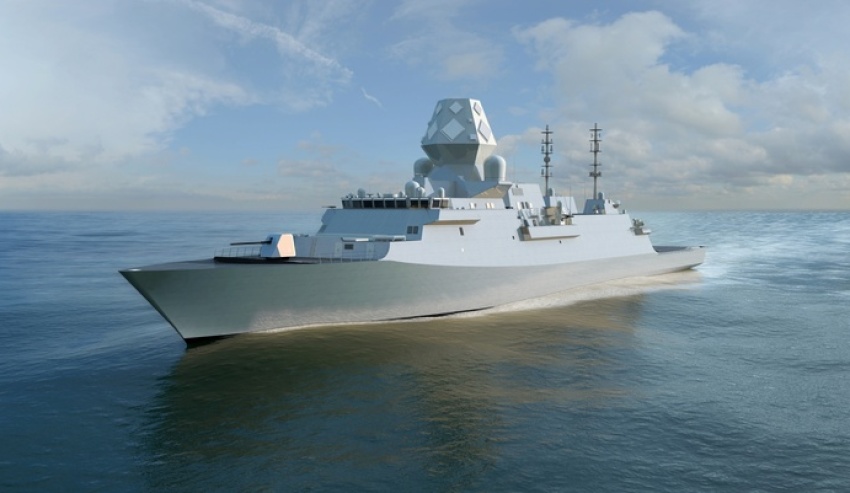BAE Systems has the weight of the UK government behind it as it looks to secure the $35 billion SEA 5000 Future Frigates contract.
To continue reading the rest of this article, please log in.
Create free account to get unlimited news articles and more!
UK Defence Secretary Gavin Williamson this week announced that Type 23 anti-submarine frigate HMS Sutherland will visit Sydney, Perth and Adelaide next year, with the Defence Secretary flagging the opportunity for joint exercises between the two nations.
Under Secretary of State for Defence Procurement Harriett Baldwin also visited Australia in November and announced the UK is looking into incorporating the Australian ‘CEAFAR’ radar, developed by CEA Technologies, on future British warships.
The radar is already in service with the RAN and a capability study to fit the radar to British ships will begin early next year. If successful, the UK would be the phased array radar's first international customer.
Under Secretary Baldwin's visit came just months after Minister for Defence Industry Christopher Pyne and the former secretary of state for defence Sir Michael Fallon held the first ever Aus-UK Ministerial Defence Industry Dialogue, discussing defence materiel and industry co-operation between the two nations.
Sir Michael said at the time, selection of the BAE Systems bid for the SEA 5000 project would create ample defence export and job opportunities for Australia.
"It is being put forward to the Australian government by BAE systems who have a well established track record in Australia, a good record in local employment," said Sir Michael.
"[It] will be be able to offer opportunities along the supply chain to a whole range of Australian companies."
The former defence secretary was adamant that regardless of whether BAE's bid is successful, Australian companies would continue to win work on the UK's Type 26 program.
"I expect ... Australian companies to be involved in that supply chain, producing the British frigate, whether or not the Australian government chooses the Type 26 design for their frigate," Sir Michael stated.
Tasmania's Liferaft Systems Australia and Victoria's Mackay Consolidated Industries have won contracts to contribute to the UK's Type 26 frigates.
Liferaft Systems Australia, which is also a supplier to the UK's Queen Elizabeth Class aircraft carriers, will provide the Type 26 Marine Evacuation System, while Mackay Consolidated Industries will supply pipe hanger inserts, a key component in reducing underwater noise that is essential for anti-submarine warfare.
These contracts will secure more than 200 jobs across Australia and takes the number of global suppliers contracted to the UK Type 26 program to 44.
The UK's Defence and Security Organisation (DSO) has also recently launched a platform for Australian companies looking to join the supply chain and pursue defence opportunities in the UK.
Head of the Defence and Security Organisation Steve Phipson spoke with Defence Connect at the Pacific 2017 International Maritime Exposition, and said the UK industry is looking to better communicate with Australian industry to establish reciprocal trade with its new supplier registration website.
"Very often we hear this, I've had this challenge from the Australian ministers before now about, well, 'how do we get reciprocal trade going?' and it is quite straight forward to do," Phipson said.
"I think a lot of it is about communicating the process to make sure that we are able to point Australian companies in the right direction to sign up for this. So there's that one, which is good.
"The second one, which is good, is teaming up with the UK prime suppliers and using Australia as parts of their supply chain, which is something else that we are working on very hard, particularly as most of our larger companies have substantial assets here in Australia. And making sure that Australian companies are able to become part of the supply chain back to the UK is something that we're pushing for quite heavily."
Companies looking to register with UK's MoD can sign up here.
BAE Systems is offering the Type 26 Global Combat Ship Australia (GCS-A) competing for the SEA 5000 project. Fincantieri of Italy is also offering its FREMM design while Spain's Navantia has put forward its F100 design for the project. The winner will be announced in 2018. The vessels will replace the Anzac frigates from the mid 2020s.
The British firm and the UK government have committed to the transfer of more than $1.5 billion of technical design and intellectual property if BAE Systems secured the SEA 5000 project.
BAE Systems has also said it will establish a digital shipyard that will transform Australia's shipbuilding industry and facilitate a transfer of intellectual property and technical data, including the digital ship design optimised for the production of the Global Combat Ship.
The innovative digital shipyard will bring the "ship to life" during its service life, with intelligent systems, both on board and linked to those ashore, that will monitor the performance of the ship and its systems. The digital shipyard will also include an inventory of parts, including cost and acoustic signature, suppliers and their details.
BAE Systems also recently unveiled its workforce mobilisation strategy for the SEA 5000 project, with a recruitment strategy that will include an Early Careers Program to create a pipeline of apprentices and graduates throughout the build phase of the $35 billion project.
The UK contender will commit to apprentices in steelwork, mechanical, electrical and technical trades, who will be central to the company’s strategy to ensure the right breadth and depth of skilled workers are brought into the multi-decade program. The company is anticipating that, at its peak, the Early Careers Program will have a population of around 150 apprentices, which will continue throughout the 35-year program.
A graduate program for business and engineering students will also offer opportunities for international placements across the company’s global business.

 Login
Login







